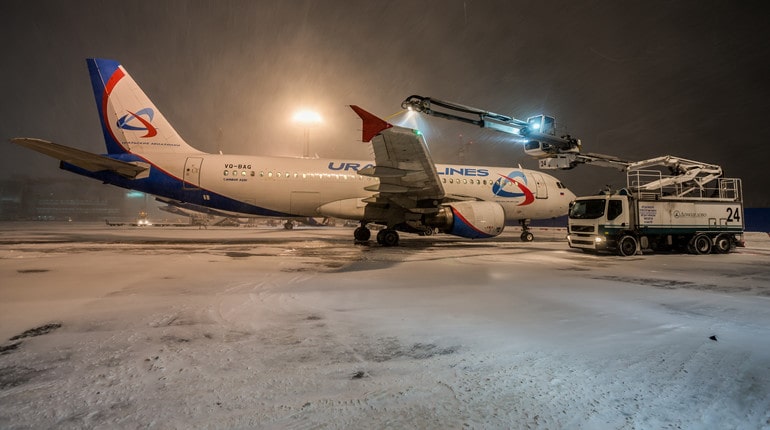Essential in aviation, especially during winter, runway de-icers are indispensable tools. In frigid conditions, icy runways pose risks to flight operations. These specialized anti-icing solutions come in both liquid and solid variations, each offering unique applications and advantages.
We will delve into the strengths and limitations of these runway de-icers, offering valuable insights for aviation professionals and safety enthusiasts. Join us on this exploration of the essential roles that both liquid and solid runway de-icers fulfill in guaranteeing safe and punctual flights.
Liquid Runway Deicers
Liquid runway deicers form a crucial part of an airport’s toolkit for dealing with winter weather hurdles. Typically, these solutions involve a mixture of water and specialized chemicals, with glycol-based compounds often taking a prominent role. What distinguishes liquid runway deicers is their adaptability and effectiveness in combatting icy conditions.
A pivotal advantage of liquid runway deicers lies in their swift application process. Airports can deploy specialized vehicles equipped with sprayers to evenly distribute the liquid solution over runways and taxiways. This rapidity proves indispensable in minimizing disruptions to flight schedules during snowfall or freezing rain events.
Additionally, liquid runway de-icers create a thin, protective coating on runway surfaces, successfully inhibiting the accumulation of ice and snow. This ensures enhanced grip for aircraft during takeoffs and landings, reducing the risk of skidding and accidents. The efficiency of swiftly restoring runway safety makes liquid de-icers a common choice among airlines and airport authorities.
However, it’s crucial to acknowledge that liquid runway de-icers come with their limitations.
Environmental issues arise from the flow of chemicals into nearby ecosystems, a subject we will explore more deeply in our comparative examination. Despite these reservations, the efficacy of liquid runway deicers remains an indispensable asset in countering winter weather challenges at airports.
Solid Runway Deicers
In contrast to their liquid counterparts, solid runway deicers are available in diverse forms, such as granules and pellets. These solid deicers are distinguished by their durability and distinctive applications in addressing winter weather challenges on airport runways.
A notable advantage of solid runway deicers lies in their resilience. Upon application to runways, they release their de-icing agents gradually, offering extended protection against ice and snow buildup. This prolonged effectiveness proves particularly invaluable in regions plagued by persistent snowfall or prolonged freezing periods.
Solid runway deicers, which include solutions like calcium chloride bags, often gain favor due to their reduced environmental impact when compared to liquid alternatives. The controlled release of de-icing agents minimizes chemical runoff and the contamination of nearby ecosystems. This aligns seamlessly with environmental sustainability objectives, rendering solid deicers an appealing choice for eco-conscious airports and regions.
Nonetheless, it is essential to acknowledge that the application of solid runway deicers may necessitate more time and specialized equipment in comparison to liquid deicers. This can impact the speed at which runways are cleared for aircraft operations. In the following section, we will explore factors that airports and aviation experts need to assess when deciding between liquid and solid runway de-icers.
Comparing Liquid and Solid Deicers
As airports grapple with the winter weather challenges, the decision regarding the use of liquid or solid runway deicers takes on critical importance. To make a well-informed choice, let’s conduct a comprehensive side-by-side analysis of these two distinct deicing categories.
Effectiveness and Application: Liquid runway deicers shine in terms of swiftness and application ease. They swiftly coat runways with a protective film, ensuring the rapid removal of ice and snow. This quick response is vital for adhering to flight schedules. Conversely, solid runway deicers, including solutions like calcium chloride bags, provide enduring protection due to their gradual-release characteristics. Although they may necessitate more time for application, their durability proves advantageous, particularly in protracted winter conditions.
Environmental Impact: In the realm of environmental impact, solid runway deicers emerge as champions. They earn favor for their minimal ecological footprint, thanks to controlled chemical release and limited runoff. This aligns seamlessly with sustainability objectives, rendering solid deicers an eco-conscious selection. Conversely, while liquid deicers exhibit effectiveness, concerns arise regarding chemical runoff and its potential ecological repercussions.
Cost-Effectiveness: Cost considerations weigh significantly in de-icing operations. Liquid deicers may boast lower initial costs owing to swift application, yet their efficiency may mandate frequent reapplications. Solid deicers, though entailing a more substantial initial investment, often yield long-term cost savings due to their sustained effectiveness.
This comprehensive comparison underscores that the choice between liquid and solid runway deicers hinges on specific operational necessities, environmental responsibilities, and budgetary constraints. Both options present distinct merits and drawbacks, and grasping these factors proves imperative for airports in making informed decisions to ensure safe and efficient winter operations.
Conclusion
In summary, the decision between liquid and solid runway deicers involves a delicate equilibrium of factors. Liquid deicers offer speed and efficiency, ensuring swift clearance of runways. However, they raise environmental concerns. On the flip side, solid deicers, including options like calcium chloride bags, prioritize longevity and environmental friendliness but may require more time for application.
Ultimately, airports face the challenge of balancing operational requirements, environmental obligations, and budget constraints when selecting between these indispensable tools. Both liquid and solid runway de-icers are crucial for winter aviation safety, each with its unique strengths and weaknesses. Understanding these factors empowers aviation professionals to make informed choices, enhancing safety and efficiency in all conditions.



